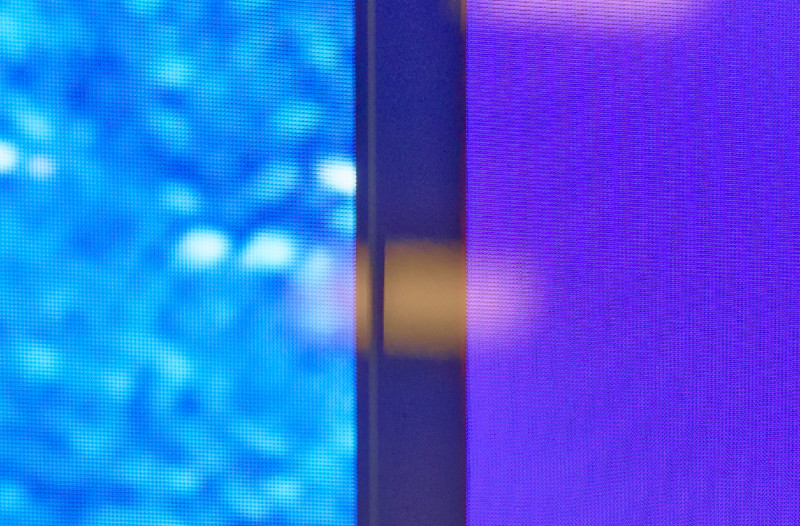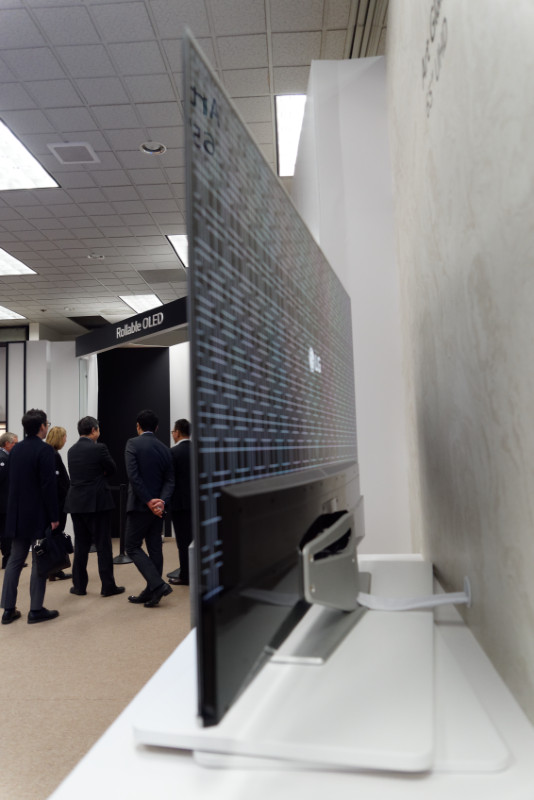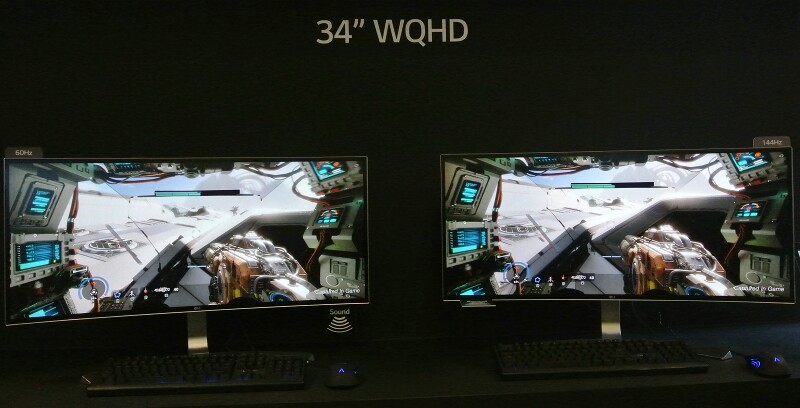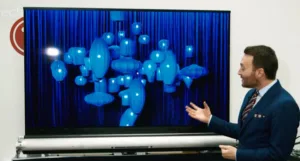LG Display had a lot to talk about, but once again we found it frustrating! Last year, on the analyst day, the company wouldn’t let us take photos, but then decided to let the consumer press do so. This time, they let people take pictures on the first day, but not on the second day when your reporter went by. “Why?”, we asked. “Just a change in management opinion”. So, we don’t have the pictures we would have liked and, these days, digital cameras are also a very important way of taking notes, so we certainly missed some points.
OLEDs for TV
As we have reported over the last year, LG Display had a good 2017 with its OLED panels. At the show, there were a number of significant new technologies that may impact the market, although not so many of them in the coming year.
The first item that we had a quick look at (at a distance) was an 88″ 8K OLED. The unit looked as good as you would hope from an OLED and that the device exists at all is a testament to LG’s engineers. As we have said before, increasing the resolution of large OLEDs is a challenge because there needs to be some dynamic adjustment of the image quality and the more pixels you have, the more adjustment you have to do, but, usually, the less time that you have to perform the update. We spoke to an LG Display engineer some years ago at SID who despaired of being able to achieve even UltraHD, and that barrier has been thoroughly broken. LG Display said that the 8K display was able to avoid reducing the brightness compared to UltraHD panels.
However, we suspect that the display was running at a low refresh rate – and, elsewhere at CES on the Samsung booth the judder that is sometimes seen in 8K was obvious. One of the challenges in moving to 8K is that refresh rate also has to move up and that will be a challenge. Still, I wasn’t sure that I’d ever see a large 8K display, so it could be that the LG engineers will solve the problems.
Perhaps the most exciting demonstration at the show was of a 65″ rollable UltraHD OLED TV panel. This display was being shown rolled down into a box and we heard that the display was made on an 80 micron glass substrate. There’s a good video by CNN here.
We captured this frame from the CNN video as it shows the mechanism better. Image:CNN
LG should also be able to make the display on a flexible plastic substrate, in the longer term which might be more practical in the longer term. One of the secondary advantages of the rollable form factor is that the display can be set for a very specific aspect ratio to match the format of a movie without ‘black bars’.
As well as these two panels, LGD showed an 86″ OLED that was said to have in-cell touch. As far as we are aware, that’s the first time that a large OLED has been shown with this kind of technology. However, given the challenges for OLEDs in professional applications where there might be static images, we’re not sure where the obvious application of the technology is. LGD also showed us how its OLED panels could be edge-overlapped to create an effect of an almost seamless video wall (or at least reducing the bezel by half) and said that it was the first time we would have seen it. However, we actually saw this effect at the Technology Exposed event a couple of months ago!
 LG’s slim displays can have the Bezel overlaid. Image:Meko
LG’s slim displays can have the Bezel overlaid. Image:Meko
Still in the digital signage space, the next product we looked at was an 88″ ‘stretch’ LCD that is 32:9 aspect ratio and is basically like two combined 49″ LCDs. The company also had two new 55″ FullHD LCDs for video wall applications that are said to have 0.6mm symetrical bezels, giving an image to image spacing of 1.2mm, the company told us. It also told us that it has significantly improved the uniformity compared to the previous generation of very narrow bezel panels.
Next we looked at the latest generation of the ‘Audio by OLED’ technology that now supports three audio channels, rather than the two shown last year. This means that a 3.0 audio set up could be created without speakers, or a 3.1 with a sub-woofer. The centre audio area could be used for voice.
Exploiting the Backlight
One of the features of LCD is that they have backlights and LG had an idea that by leaving some parts of the back panel of a TV panel cover, a pattern could be shown and illuminated by light that would otherwise be wasted.
 LG Display showed this Art Glass concept – the pattern is lit by the backlight. Image:Meko
LG Display showed this Art Glass concept – the pattern is lit by the backlight. Image:Meko
The technology is just an idea at the moment, but would not be too difficult to implement if a client was looking for this kind of feature. (It occurs to us that gaming monitors might be an application for this, but, of course, the gamers like coloured LEDs!)
LG has been following the trends to WCG and at the show it had the next generation of its Nanocell technology which was originally based on polariser technology but which now has a nano organic film that filters the red and green light to allow more pure primaries. The company said that the 65″ panel could reach 85% of the full Rec. 2020 gamut and 99% of DCI P3. It also has peak brightness of 700 cd/m² and can support 120Hz refresh.
As well as the OLED, there was an 8K 75″ IPS LCD panel which uses the nanocell technology and is likely to be in the market before the OLED, although it will probably be in 2019 as the panel is planned to have 120Hz refresh and use an oxide TFT substrate.
IT Displays Continue Evolution
Away from the TV and LFD area, LGD had a new laptop display with significantly lower power consumption of 1.925 watts, well below traditional panels. The panel is based on an a-si TFT substrate and the company expects that when it can switch to oxide, later, it will have even better results. Also in the notebook space was a 13.3″ FullHD LCD that offers in-cell touch that supports a pen with pressure and tilt. At the moment the levels of pressure are coarse, but it is expected that this will improve going forward. However, it does enable very slim, but pen-enabled notebooks and 2 in 1s.
Another feature that’s new is the Crystal Sound technology which uses the idea of vibrating the panel directly to create sound, as has been done in OLEDs in the past, but is now being implemented in LCD. The technology exploits the advantage of IPS in being much more stable under vibration than VA technologies, which will tend to flash visually when vibrated.
In the monitor area, there was a 31.5″ 8K panel and a new 31.5″ UltraHD panel that has 600 cd/m² of output and should enable monitors to meet the VESA HDR600 label requirements. The company is also developing a 34″ 21:9 version. These monitors both have edge-lit panels but the firm is developing direct lit panels with 1,000 cd/m² that should be available later.
 LG showed 34″ wide monitors with fast refresh. Image:Ken Werner
LG showed 34″ wide monitors with fast refresh. Image:Ken Werner
Medical is a new Area
As the huge new Chinese fabs take over the commodity TV LCD panel market, the traditional suppliers in Taiwan and Korea will need to move to added value segments, and LGD showed some new panels for medical applications. There was a new 21.3″ QXGA display that supports 3 megapixels for radiology and has high contrast, enabled by improved UV alignment of the LC layer. Also shown was an UltraHD 31.5″ panel that has 1,000 cd/m² of peak brightness and is said to be optimised for surgical applications. The colour performance has been especially tuned, especially in the reds, to optimise for that application.
Analyst Comment
The rollable OLED is a very elegant, but I do have concerns about how robust it is. The display shown has a frame that is presumably driven by some gearing and supports the display, but such thin glass is bound to be delicate if it is so thin. I have no concern about rollability – both Corning and AGC have talked a lot about how flexible thin glass can be, but we all know how delicate our smartphones are. A plastic substrate should be better in this respect. Of course, you could always encapsulate the display in a glass envelope. That would leave the glass visible, but would eliminate the ‘black hole on the wall’ problem that I highlighted in a Display Daily a couple of months ago. (The Black Hole on the Wall).
The 8K panel is a considerable achievement and LGD deserves congratulations. LG & NHK have been working on this concept (and rollable displays) for some time. One thing that struck us is that LG Display said at the Munich event that it was looking at developing a smaller panel to meet the demand in Europe, and it occurred to us that if LGD can make an 86″ 8K, with the same pixel architecture, it could make a 43″ UltraHD panel.
It was notable to us that LGD didn’t promote any better performance in the key brightness and lifetime issues of OLED for 2018. That suggests that the company may have hit a roadblock in this area. If that is the case, the aggressive technical work being done by Samsung to overcome the limits of LCD may start to dent the options for OLED in the future, if performance is the only issue. However, I don’t see a rollable LCD on the horizon any time soon! (BR)

